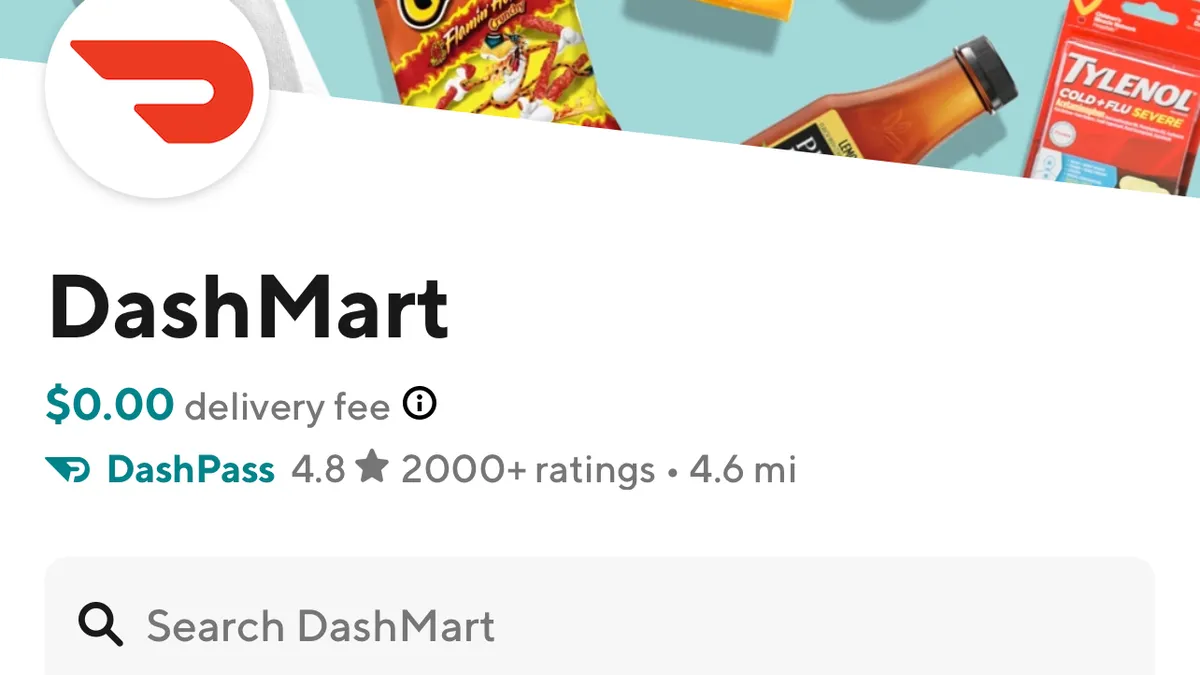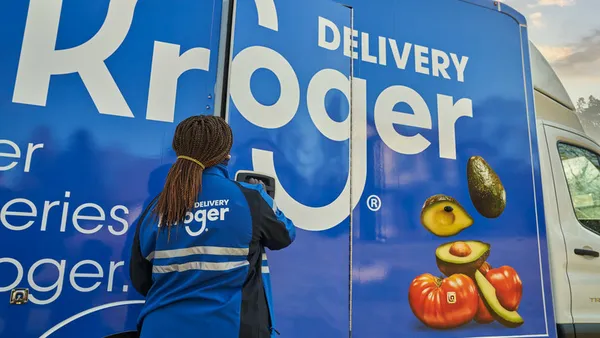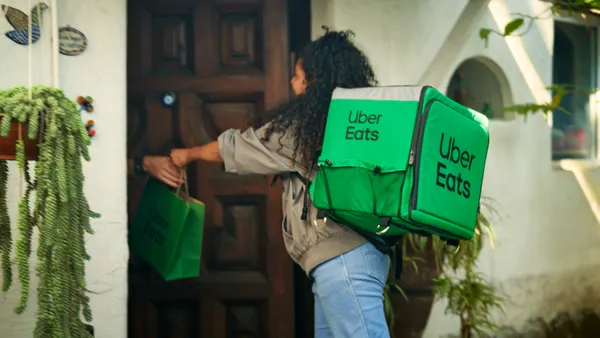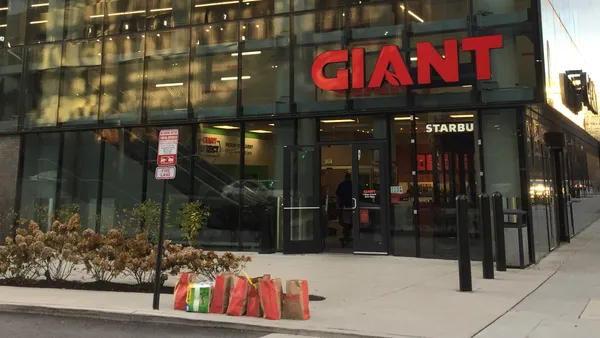Pardon the Disruption is a column that looks at the forces shaping food retail.
DoorDash announced yesterday that it’s speeding into ultrafast delivery, bringing its considerable scale and savvy to a space that’s become notable more for its ability to burn through investor cash than to sell through groceries and impulse items.
DoorDash has the firepower to become a major player in the budding industry. Millions of consumers already rely on it for quick restaurant delivery, and the company has the capital to go shopping for any competitors that run out of monetary fuel. There should be a few more of those in the months ahead as startups, like meal kit competitors circa 2018, plow money into new real estate and shopper giveaways aimed at locking down loyalty.
For as much noise as DoorDash has made about the announcement, however, it appears to have its eyes on a larger prize. Instead of rapidly growing its own ultrafast empire, it plans to hone the operational model for DashMart ultrafast delivery before eventually offering it to retailer "partners" as a service, Fuad Hannon, the company’s head of new verticals, told me in an email.
"We see a larger opportunity to help our partners offer quick deliveries to customers, and believe we can take our learnings and play an active role in applying them to our partners’ businesses," he wrote. "Our plan is to test, iterate and learn with DashMart and ultimately expand this service to partners."
And it isn’t just 15-minute delivery service that DoorDash plans to offer. Hannon told me recently its DashMart dark stores and systems, which have been running since that service's launch in 2020, could power a range of programs for retailers, from instant-needs delivery similar to what Gopuff offers to unique services like a private label marketplace. It could probably extend traditional full-service grocery delivery, too, by fulfilling fast-moving goods for retailers.
DoorDash is becoming an expert in dark stores at a time when retailers, from grocers to c-stores and nonfood retailers, are starting to really need them. Food e-commerce has reached new heights during the pandemic, and stores are in many cases straining to efficiently keep up with demand. Consumers are also tired of having to wade through seemingly endless order substitutions and surprise out-of-stocks because stores can’t sync up inventory with their platforms. Dark stores, which are made to fill online orders and only service that one demand stream, don’t have that problem.
Retailers also need to be ready to offer new online shopping services centered around speed and selection. Young consumers that have grown up shopping and playing on their smartphones will gain significant spending power in the years ahead. Many of them will want speedy service and a digital storefront and assortment that fits with the app format. Although the ultrafast delivery market is a circus right now, I don’t think retailers should discount the power of a pared-down service that offers a tailored product list and delivery in around 30 minutes.
It’s for many of these reasons that Instacart announced in July its partnership with automated micro-fulfillment provider Fabric to build fulfillment solutions for retailers. And it’s why the company appears to also be exploring its own entry into the 15-minute delivery, according to reports.
Competing against DoorDash
Instacart holds a dominant position as an e-commerce provider for grocers, but DoorDash is rapidly signing on retailers like Albertsons and Weis Markets for its marketplace and delivery services. It may see dark stores as its opportunity to edge ahead of Instacart, which was late to develop the fulfillment services retailers were inevitably going to need, only doing so after the pandemic forced its hand.
Retailers, though, may have a problem with DoorDash’s choice to be both a retailer and a service company. Indeed, for all the debate in industry circles over whether Instacart will become an online grocer, made amid statements from the company that it will never compete with retailers, the fact is DoorDash is already employing this very strategy in markets across the country.
I got a front-row seat to this conundrum when DashMart launched in my South Seattle neighborhood recently. Because I’ve ordered restaurant delivery through the company in the past, I got an email notification late last month saying I could now get groceries delivered through the app. When I opened it up, I went to the “Grocery” tab and found two services listed one atop the other: DoorDash delivery from Safeway stores, which carries a $3.99 delivery fee, and delivery from DashMart, which has no fee. DashMart is also listed prominently on the app’s main page under the “Try Something New” teaser.
DashMart doesn’t carry near the assortment Safeway does, though it has a lot of what shoppers want, including fresh produce, meat, jugs of milk and pints of locally made Salt & Straw ice cream. If consumers are looking to grocery shop through the DoorDash app, there’s a good chance they’ll skip over Safeway for DashMart in that scenario.
This is an annoyance for grocers and convenience store operators in the short-term, and could potentially become a very big one if DoorDash decides to significantly expand its online retail operation. Despite the company’s claim that it’s sharpening its operational acumen in dark stores ahead of a service rollout for retailers, there’s nothing stopping it from a rapid build-out of its own DashMarts and expansion into other services, possibly grocery delivery.
I asked Hannon exactly how many DashMarts the company currently has, and he told me, vaguely, that there are currently "over 25" locations. Neither he nor the company elaborated on expansion plans for DashMart or any other delivery services it might be working on.
I’m not knocking DoorDash for following this strategy or advocating for one e-commerce service over another. The company is dashing after every valuable opportunity it sees in grocery and convenience as those industries go through a transformative digital shift and investors push it to grow beyond its core restaurant services.
But grocers need to be clear-eyed on the competitive dynamics at play. DoorDash is a company that can help them find new shoppers and deliver orders to them faster than they could on their own. It’s also a company that’s showing it could steal away those shoppers, depending on how it evolves.
DoorDash’s seemingly contradictory approach to grocery e-commerce underscores just how vast and ever-changing the digital food space is these days. New channels are emerging that redefine the traditional lines between grocery and convenience, while companies are still trying to rein in costs and strike the right balance between speed and price across a range of consumer needs. Opportunities for creative partnerships abound, and the company that’s one day your ally may be your enemy the next.












